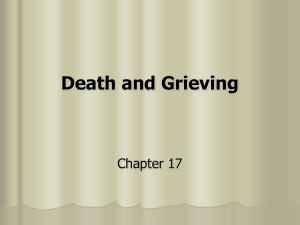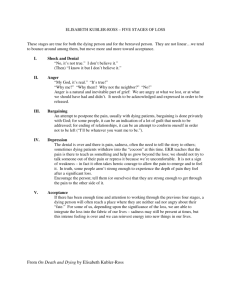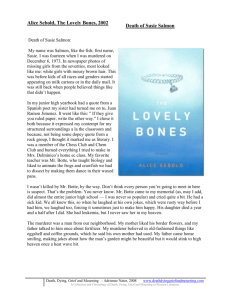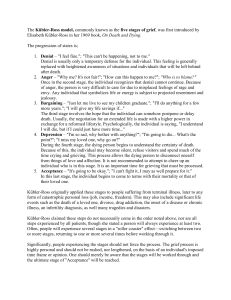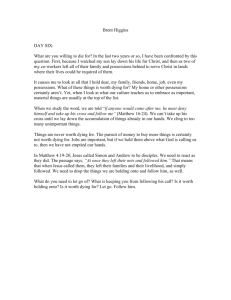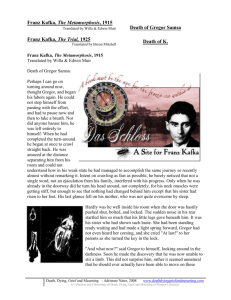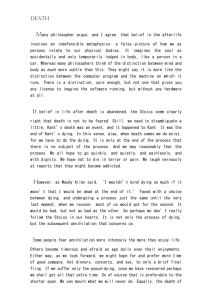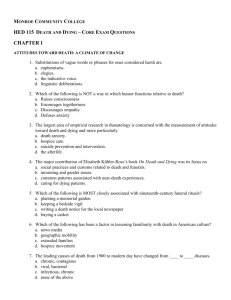Introduction to Psychology
advertisement
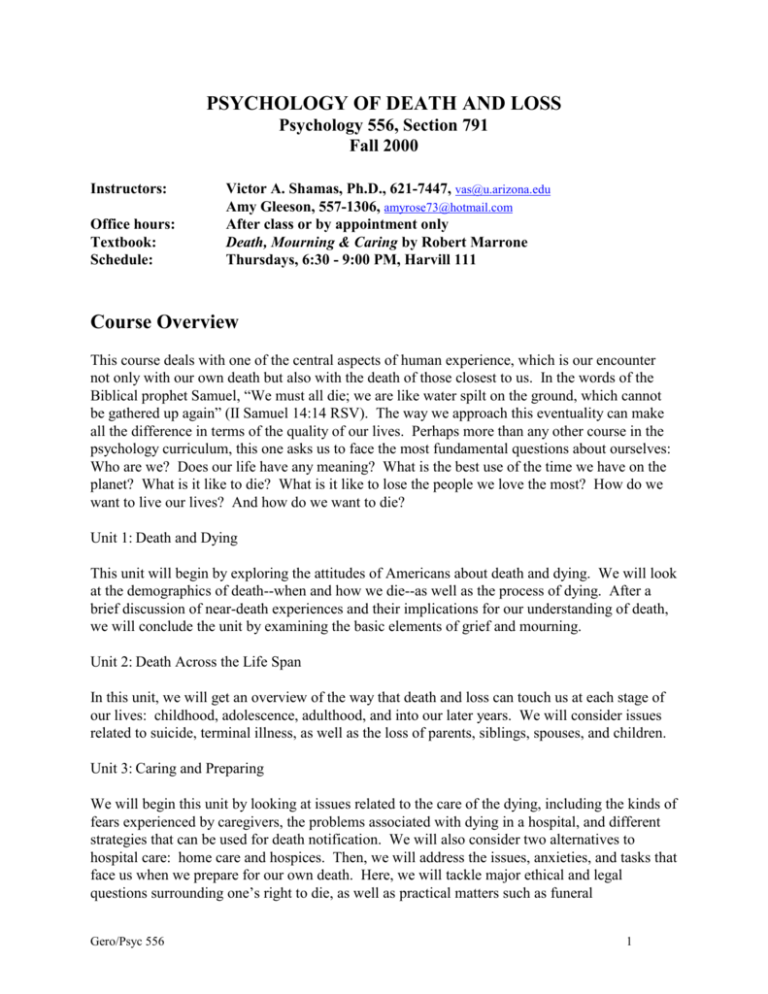
PSYCHOLOGY OF DEATH AND LOSS Psychology 556, Section 791 Fall 2000 Instructors: Office hours: Textbook: Schedule: Victor A. Shamas, Ph.D., 621-7447, vas@u.arizona.edu Amy Gleeson, 557-1306, amyrose73@hotmail.com After class or by appointment only Death, Mourning & Caring by Robert Marrone Thursdays, 6:30 - 9:00 PM, Harvill 111 Course Overview This course deals with one of the central aspects of human experience, which is our encounter not only with our own death but also with the death of those closest to us. In the words of the Biblical prophet Samuel, “We must all die; we are like water spilt on the ground, which cannot be gathered up again” (II Samuel 14:14 RSV). The way we approach this eventuality can make all the difference in terms of the quality of our lives. Perhaps more than any other course in the psychology curriculum, this one asks us to face the most fundamental questions about ourselves: Who are we? Does our life have any meaning? What is the best use of the time we have on the planet? What is it like to die? What is it like to lose the people we love the most? How do we want to live our lives? And how do we want to die? Unit 1: Death and Dying This unit will begin by exploring the attitudes of Americans about death and dying. We will look at the demographics of death--when and how we die--as well as the process of dying. After a brief discussion of near-death experiences and their implications for our understanding of death, we will conclude the unit by examining the basic elements of grief and mourning. Unit 2: Death Across the Life Span In this unit, we will get an overview of the way that death and loss can touch us at each stage of our lives: childhood, adolescence, adulthood, and into our later years. We will consider issues related to suicide, terminal illness, as well as the loss of parents, siblings, spouses, and children. Unit 3: Caring and Preparing We will begin this unit by looking at issues related to the care of the dying, including the kinds of fears experienced by caregivers, the problems associated with dying in a hospital, and different strategies that can be used for death notification. We will also consider two alternatives to hospital care: home care and hospices. Then, we will address the issues, anxieties, and tasks that face us when we prepare for our own death. Here, we will tackle major ethical and legal questions surrounding one’s right to die, as well as practical matters such as funeral Gero/Psyc 556 1 arrangements, will preparation, and power of attorney. Finally, we will explore the rituals and practices developed in different parts of the world to honor the dead and to comfort the living. Course Structure Because this is a graduate seminar, most of our class time will be spent in dialogue. Every Thursday evening, you should come to class prepared to discuss major issues and ideas related to death and loss. On a regular basis, guest speakers will join us to share their expertise, answer questions and dialogue with us. The course is divided into three units and at the end of each unit there will be an examination. The units are subdivided into 18 lessons and every lesson has a set of Objectives and Key Terms. the exams will only cover material listed in the Objectives and Key Terms. Each unit also includes three practice tests reflecting the kinds of questions found on the examinations. In general, class time will be divided into two parts. Lectures by guest speakers or by the instructors will take up the first half of class. Then, during the second half, we will discuss the week’s Focus Task. Grading Policy You are expected and encouraged to attend all class meetings, although attendances is only required on the following four dates: Midterm 1: Midterm 2: Poster Sessions: Final Exam: September 21 October 26 November 30 December 14, 6:30 – 8:30, Harvill 111 Your grade for this course is based on the three exams, your weekly journal and the poster. Total points will be distributed as follows: Midterm 1: Midterm 2: Final Exam: Journal: Poster: TOTAL 30 points 30 points 60 points 20 points 40 points 180 points You will be graded on the following scale: Gero/Psyc 556 2 GRADE A B C D F RANGE 160-180 140-159 120-139 100-119 below 100 The two midterms consist of 30 questions, and the final exam will have 60 questions. Each question is worth one point, and you can earn a possible 120 points on the exams. On the final, approximately 40 questions will address the material in Unit 3 and the other 20 will be divided equally between Units 1 and 2. All questions are multiple-choice and consist of four choices. The tests are computer-graded, which means that you will need to bring a Number 2 pencil to the exams and to make sure that you fill in the accompanying bubble sheet according to the instructions that will be provided. One point will be deducted for any bubble sheets that are filled out incorrectly. All of the exams are in-class, closed-book and closed-notes tests. You will have one hour to complete each midterm and two hours for the final. Students who arrive more than 30 minutes late for an exam will not be allowed to take it, There are no make-up exams in this course and no grade of incomplete. If you fail to show up for an exam or if you arrive more than 30 minutes late, you will be awarded zero points. Please take this policy into account when scheduling your holiday travel. Every week, you must make at least one 2-page entry into your journal. The journal entry should deal in some way with the Focus Task for that week. (To learn more about the Focus Tasks, see the next section). Because these journal entries will be dealing with subject matter of a personal nature, we will not be grading the content in any way, except to see that you in fact did express thoughts and feelings related to the Focus Task for each week. Points for the weekly journal will be awarded in an all-or-nothing manner: If you have made all of the entries in a timely manner, you will receive the full 20 points. If the journal is incomplete or if your weekly entries fail to deal with the subject matter, you will receive zero out of 20. Make sure to bring your journal with you on December 14 and to hand it into us when you turn in your final exam. Journals will not be accepted after that date, and late journals will receive a score of zero. During the last regular class session of the semester, you will present an academic poster on a topic of interest related to the theme of the course. For your poster, you can either collect new data, re-analyze existing data, or present a review of the literature that provides a new theoretical interpretation of published findings. Posters are worth 40 points and will be graded on the following criteria: scholarship (8 pts), clarity (8 pts), relevance to course theme (8 pts), originality (8 pts), and aesthetics (8 pts). The class period on November 30 will be divided into two sessions: Gero/Psyc 556 3 SESSION 1 2 TIME 6:30 – 7:30 7:45 – 8:45 PRESENTERS Last names beginning with A-J Last names beginning with K-Z Please invite friends and family to attend the poster sessions. We will have a potluck dinner that night and guests are welcome. Focus Tasks The Focus Tasks are intended to stimulate your thoughts and feelings about the course material and also to be the starting point for our weekly class discussions. Next to each Focus Task (FT) listed below is the date of the class session in which we will be discussing it. You are expected to have thought about the FT, to have done the appropriate readings and to have made your journal entry at some point during the week prior to that date so that our class discussions can be more focused and effective. 8/31- FT1: Read the online article “Mourning in America” by Beth Baker (www.u.arizona.edu/~vas/mourn.htm). Think back to experiences you’ve had around the death of a close family member of friend. What were your experience like? What cultural attitudes and beliefs about death and about the expression of grief were reflected in the rituals that took place? To what extent does the “Mourning in America” article relate to your experiences? 9/7- FT2: Read “I'd Pick More Daisies” (www.u.arizona.edu/~vas/daisies.htm ) and “Impermanence” by Sogyal Rinpoche (www.u.arizona.edu/~vas/imperm.pdf ). Come up with a list of the things that make life worthwhile for you. These could be people, activities, experiences, places, ideals, or anything else you can think of. Then consider the following scenario: You only have a few weeks or months to live and you want to make the most of your time. What will you do differently? How will your daily life change? 9/14- FT3: Read the following two poems: “Sonnet XXX” by William Shakespeare (www.npr.org/programs/death/readings/poetry/shake.html) and “No Goodbyes” by Paul Monette (www.npr.org/programs/death/readings/poetry/monette.html). Also read the transcript of “Roundtable: Grief and Bereavement” (www.npr.org/programs/death/971125.death.html). Compare the perspectives on bereavement presented in the two poems and by the roundtable participants. With which of these perspectives do you relate the most? With which do you relate the least? Explain. 9/28- FT4: Read the excerpt from a “A River Runs Through It” by Norman Maclean (www.npr.org/programs/death/readings/stories/maclean.html). Focus specifically on the reaction of the narrator to the death of his brother. What emotions do you observe? What can you infer about the nature of their relationship? If you or someone you know has lost a sibling, compare the reactions and emotional experiences of the people in your own life to those described in this reading. 10/5- FT5: Read “For a Radiant Star” (www.u.arizona.edu/~vas/radiant.pdf). Note your own thoughts and feelings as you read Ken Wilber’s account of the death of his wife Treya. What can you Gero/Psyc 556 4 infer about the nature of the relationship between the wife and husband in this story? How would you react if you were in the husband’s situation, witnessing the death of your spouse at a relatively young age? 10/12- FT6: Read “His Wide Mouth Home” by J. Augustine Wetta (www.npr.org/programs/death/readings/essays/wetta.html). What reaction did you have to this essay? How would you feel if you were the parent in this story? Or the lifeguard? What insights does this essay have to offer? 10/19- FT7: Read FT10: Read “Listening to Midlife” by Bill Dwyer (www.consciouschoice.com/issues/cc086/listeningtomidlife.html) and “Fears at 40 Something” by Paula Payne Hardin (www.consciouschoice.com/issues/cc086/fearsat40something.html). Compare the two views of aging presented in these articles. Think about what it will be like to grow old. What are your greatest concerns or fears about growing older? What benefits, if any, can you see coming out of the aging process? 11/2- FT8: Read “Life Support: Three Nurses on the Front Lines” by Suzanne Gordon (www.npr.org/programs/death/readings/essays/gordon.html). What impressions do you get, based on this article, about the training and the support received by medical professionals when it comes to dealing with death? What changes would you propose making to this system? To what extent do you see the existing problems as a function of the individuals involved, of the system in which they work, and of the culture in general? Explain. 11/9- FT9: Go through the questions on p.327 of your textbook. Write down your answer to each one, as well as any thoughts or feelings you have while doing this exercise. Also, read “A Good Death” by Pythia Peay (www.u.arizona.edu/~vas/good.htm). Discuss what you consider to be a “good death.” FT10: Read “The Unknown Soldier” by Luc Sante (www.npr.org/programs/death/readings/stories/sante.html). What feelings does this reading evoke in you? How do you want to be remembered when you die? What legacy, if any, do you think you will leave behind? Scheduled Topics In general, our class meetings will focus on questions and issues related to specific chapters of the textbook and specific focus tasks. Here is the schedule of topics we will be covering: 8/31- CH.1: American Attitudes Toward Death and Dying CH.2: Death in America: When and How We Die 9/7- CH.3: Dying and the Near-Death Experience 9/14- CH.4: The Work of Mourning 9/21- MIDTERM 1 9/28- CH.5: Death, Dying, and the Child 10/5- CH.6: Death, Suicide, and Young Americans Gero/Psyc 556 5 10/12- CH.7: Death, Adulthood, and a Parent's Tears 10/19- CH.8: Aging, Mourning, and the Search for Meaning 10/26- MIDTERM 2 11/2- CH.9: Caring for the Dying 11/9- CH.10: Preparing for Death 11/16- CH.11: Honoring the Dead, Comforting the Living 11/23- THANKSGIVING 11/30- POSTER SESSIONS 12/14- FINAL EXAM Small Group Guidelines The small group discussions may deal with topics of a highly personal nature, in which participants may be asked to talk about their concerns, emotions, and past experiences around issues of death and loss. We want each person to feel safe and comfortable expressing their thoughts and feelings in the context of these discussion. The only way this can happen is if each of you agrees to follow certain basic guidelines: 1. Always treat the other members of your group with complete respect. Listen to what other people are saying without judging, advising or critiquing their comments. And never attack someone personally or mock them, no matter how much you may disagree with what they have to say. 2. Come prepared. Make sure you do the weekly Focus Task before you come to class, so that you can benefit fully from the discussion. 3. Let other people have their say. Don't dominate the discussion. You can learn at least as much by listening to others as you can by speaking. 4. Don't censor yourself. On the other hand, if you need the time to express yourself and the other group members are willing to listen, feel free to say what is on your mind. Also, if you disagree with something being said in your group or if you feel that one person is dominating the discussion, state your opinion. 5. Cultivate the discussion. Ask questions of other people and genuinely try to understand their position. Also, use a light touch to keep the discussion on-track. Don't feel that you have to answer every question yourself or to give unsolicited advice to the other group members about their personal problems. Nothing kills a discussion faster. 6. Treat each person in the group as your teacher. You can always benefit from the experience and the insight gained by your peers. Take the time to understand what they're saying. 7. Give the group your undivided attention. If you are bored or upset by the discussion, don't shut yourself off from the group. By expressing these feelings in a respectful way and listening to other people's responses, you may learn something important from the discussion. Or, if you Gero/Psyc 556 6 feel the discussion has gotten stuck, use a gentle touch to nudge it in a more constructive direction. If you become overwhelmed or frustrated and are unable to proceed, then excuse yourself politely from the group. Your Instructors Victor Shamas received his Ph.D. in Cognitive Psychology from the University of Arizona in 1994 and his MS in Chemistry from the University of California, Santa Cruz in 1984. He has taught Introduction to Psychology, Research Methods, Psychological Measurement and Statistics, Cognitive Psychology, Psychology of Love and Spirituality, Human Development, Biopsychology, Cognitive Development, Personality, Social Psychology, Abnormal Psychology, Sensation and Perception, Adult Development and Aging, Psychology of Death and Loss, Psychology of Consciousness, Thinking Reasoning and Problem-Solving, and IndustrialOrganizational Psychology. He has been a member of the faculty at The Evergreen State College, St. Martin’s College, Green River Community College, and the University of Arizona. Amy Gleeson has a B.S. in Family Studies from the University of Arizona and has done curriculum development for the Tucson Unified School District, UA Extension and Prentice Hall. She recently co-authored an online study guide for the textbook Human Development by F. Philip Rice (Fourth Edition) and helped develop correspondence courses in Research Methods and Cognitive Development. She is also in the process of submitting her first research paper for publication and plans to begin graduate work in Developmental Psychology next fall. Your Textbook The textbook for this course is Death, Mourning & Caring by Robert Marrone, published in 1997 by Brooks/Cole (ISBN 0-314-09979-6). All readings listed in the course outline are either from this book or from one of the readings on reserve in the library. Gero/Psyc 556 7 COURSE OUTLINE Unit I: Death and Dying Lesson I-1: The Pattern of Invisible Death, part 1 (CH.1, pp.4-9) Objectives: a) Distinguish among the views of death in the Middle Ages, in the eighteenth and nineteenth centuries, and in modern industrialized countries. Key terms: invisible death ars moriendi Lesson I-2: The Pattern of Invisible Death, part 2 (CH.1, pp.9-17) Objectives: a) Describe at least five factors that contribute to the modern view of invisible death. b) List three basic messages about death depicted in the media. c) Identify the basic findings of multiethnic studies of attitudes towards death. Lesson I-3: The Pattern of Invisible Death, part 3 (CH.1, pp.17-26) Objectives: a) Name three direct ways that people deal with conflict or threat. b) Distinguish between cognitive denial and repression. c) Indicate how actual deathbed scenes differ from those imagined by subjects in Robert Kastenbaum’s study. d) Describe five possible reasons for behavioral passivity regarding death. e) Identify factors that are contributing to an increase in openness about death. f) Explain Kastenbaum’s approach-avoidance theory. Key terms: cognitive denial repression Lesson I-4: Ethnic Variations and Change (CH.1, pp.26-37) Objectives: a) Describe the unique characteristics of each of the following groups’ attitudes towards death: African-Americans, Hispanic-Americans, and Asian-Americans. b) Point out key differences between the attitudes of the Lakota and Navajo cultures. c) Give an example of how acculturation can change a group's attitude towards death. Lesson I-5: Is America a Death-Denying Culture (CH.1, pp.37-38) Changing Attitudes and Death Education (CH.1,pp.38-41) Gero/Psyc 556 8 Objectives: a) Offer evidence contradicting the notion that Americans are death-denying. b) Describe the effects of college courses like this one on the students who take them. Lesson I-6: Transitions (CH.2, p.44) Potential Life Lost in America (CH.2, pp.44-45) Dying Trajectories (CH.2, pp.45-46) Stress and Life (CH.2, p.47) Objectives: a) Identify changes in life expectancy since the Middle Ages. b) Name the four most common causes of death in the United States. c) Describe two features of dying trajectories. Key terms: epidemiologic transitions potential life dying trajectories brief trajectory PRACTICE TEST I-A Lesson I-7: How We Die, part 1 (CH.2,pp.47-55) Objectives: a) Identify the leading candidates for heart attacks and cancer deaths. b) Describe the role of hostility in heart disease. c) Distinguish between benign and malignant tumors. d) Identify psychological factors that are linked to the onset of cancer. e) Describe basic symptoms and causes of death associated with Alzheimer’s disease. Key terms: plaques atheroschlerosis angina pectoris myocardial infarction hypertension Type A behavior pattern neoplasm metastatic Lesson I-8: How We Die, part 2 (CH.2,pp.55-61) Objectives: a) Identify the most likely homicide and suicide victims. b) Compare the firearm-related homicide rates in the U.S. to that of other nations. c) List the factors that make homicide especially hard on survivors. d) Distinguish between the suicide patterns of men and women. Gero/Psyc 556 9 e) Describe the possible relationship between serotonin and suicide. Key terms: suicidologists Lesson I-9: How We Die, part 3 (CH.2, pp.62-69) Objectives: a) Identify at least two factors that contribute to accidental deaths. b) Describe the prevalence of head injuries in the U.S. c) Name at least five factors that contribute to “family distancing” after farmrelated deaths. d) List three stages of PTSD. e) Describe common symptoms of AIDS. f) Indicate the prevalence of AIDS worldwide. Key terms: postvention post-traumatic stress disorder (PTSD) survivor’s guilt post-traumatic death syndrome acquired immune-deficiency syndrome (AIDS) human immunodeficiency virus (HIV) Lesson I-10: Communicable Diseases (CH.2, pp.69-71) Objectives: a) Describe the extent of the threat posed by infectious diseases. b) Identify the factors that contribute to increases in the rate of nosocomial infection. c) Give an example of the impact that AIDS is having on life expectancy. Key terms: nosocomial infection Lesson I-11: Dying: Stages, Phases & Tasks, part 1 (CH.3, pp.74-83) Objectives: a) Describe each of the five stages in Kubler-Ross’ model of dying. b) List two criticisms of Kubler-Ross’s model. c) Describe each of the phases in Pattison’s model. d) Name five fears that Pattison associates with dying. e) Distinguish among Pattison’s four definitions of death. Lesson I-12: Dying: Stages, Phases & Tasks, part 2 (CH.3, pp.84-88) Objectives: a) Explain what is meant by “living our dying.” b) Describe the four kinds of needs identified by Corr in his task-based coping model. PRACTICE TEST I-B Gero/Psyc 556 10 Lesson I-13: Final Moments & Near-Death Experiences, part 1 (CH.3, pp.88-94) Objectives: a) Discuss the relationship between sleep and death. Lesson I-14: Final Moments & Near-Death Experiences, part 2 (CH.3, pp.94-103) Objectives: a) Describe four dimensions of near-death experiences. b) Distinguish between the death-as-door and the death-as-wall thesis. c) List the common effects of the NDE on those who have experienced it. Lesson I-15: Biological Roots of Grieving & Mourning (CH.4, pp.106-107) Grief and the Mourning After (CH.4, pp.108-110) The Process of Uncomplicated Mourning (CH.4, pp.110-111) The Mourning After (CH.4, pp.111-114) A Model of Mourning (CH.4, pp.114) Objectives: a) Give at least three examples of mourning behaviors in animals. b) Summarize Sigmund and Anna Freud’s ideas about mourning. c) Distinguish between grief and mourning using Wrenn’s features of each. d) Identify the phases of mourning proposed by Bowlby, by Zisook, and by Harvey. e) Identify the tasks of mourning proposed by Worden and by Rando. f) Discuss five factors that contribute to the stress of loss. Lesson I-16: The Cognitive Restructuring Phase, part 1 (CH.4, pp.114-122) Objectives: a) Describe four cognitive restructuring strategies used in account making. b) List the physical disturbances that are typical of the emotional expression phase. c) Discuss the emotional reactions that are typical of the emotional expression phase. Key terms: account making secondary losses Lesson I-17: The Cognitive Restructuring Phase, part 2 (CH.4, pp.122-132) Objectives: Gero/Psyc 556 a) Describe three coping strategies that occur in the psychological reintegration phase. b) Discuss the role of self-efficacy in psychological reintegration. c) Explain how a mourner's relationship with and representation of the deceased changes during the psychological reintegration phase. d) Describe the characteristics of a mourner who has achieved reintegration. e) Identify the two qualities of spiritual experiences as identified by Klass. 11 f) Indicate how spirituality affects one's view of death, according to Ross and Pollio. Key terms: self-efficacy Lesson I-18: Complicated Mourning (CH.4, pp.132-135) Individual Differences & the Mourning Process (CH.4, pp.135-138) Grieving & Mourning: The Work Ahead (CH.4, p.138) Objectives: a) Identify four factors that contribute to complicated grief reactions. b) Indicate when denial might be adaptive. c) List the three patterns of resolution proposed by Wortman and Silver. d) Name five features that Corr considers essential to future models of mourning. Key terms: complicated mourning chronic grief reaction mummification anniversary reactions masked grief reactions broken heart syndrome PRACTICE TEST I-C TAKE FIRST MIDTERM (30 questions, 1hour) Unit II: Death Across the Life Span Lesson II-1: The Cognitive Perspective (CH.5, pp.144-151) Objectives: a) Describe each of Piaget's four stages of development. b) Indicate how children respond to death and loss at each of Piaget’s stages. Key terms: sensorimotor stage object permanence separation anxiety preoperational stage concrete operational stage formal operational stage Lesson II-2: The Psychodynamic Perspective (CH.5, pp.151-157) Objectives: Gero/Psyc 556 a) Explain Mahler’s notions of separation and individuation. b) Describe the common reactions of young dying children. c) Identify the first four stages of Erikson's life-span theory of development. 12 Key terms: autonomy vs. shame and doubt initiative vs. guilt industry vs. inferiority Lesson II-3: The Humanistic-Existential Perspective (CH.5, pp.157-163) Objectives: a) Explain how the humanistic perspective differs from other developmental models. b) Indicate how dying children differ from most other children. c) Identify three environmental stresses and three emotions faced by dying children. d) List the losses that dying children must grieve. Lesson II-4: Grieving Children (CH.5, pp.163-170) Objectives: a) Identify the possible long-term consequences of losing a parent in childhood. b) Describe Bowlby’s three stages of bereavement in the young child. c) List four emotional reactions experienced by grieving children. d) Identify five stages in a child's attempt to identify with a dead parent. e) Indicate how one can lower the anxiety level of a bereaved sibling. f) Find the main differences in the way younger and older children respond to the death of a pet . Key terms: protest despair detachment regression hyperactivity Lesson II-5: Adolescence (CH.6, pp.173-180) Objectives: a) Indicate how social conditions have affected America's view of young people. b) Distinguish among the view of death found in the three phases of adolescence. c) List the percentage of adolescence who have dealt with the death of a peer. d) Identify three factors that can keep adolescents from dealing openly with death. Key terms: self-schema death defiance Lesson II-6: Rock & Roll & Death (CH.6, pp.180-185) Objectives: a) Give examples of at least four ways that rock & roll lyrics deal with death. b) Identify a possible association between musical preference and views of death. PRACTICE TEST II-A Gero/Psyc 556 13 Lesson II-7: Perspectives on Youth Suicide, part 1 (CH.6, pp.185-192) Objectives: a) List the statistics on the incidence of teenage suicide. b) Indicate which teenagers are most likely to attempt and commit suicide. c) Describe Hudgens' theory about increases in the rate of teen suicide. d) Identify the possible significance of self-mutilation behavior in teens. e) Distinguish among Durkheim's four major types of suicide. f) Describe the social response to parents of suicide victims. Key terms: anomic suicide egoistic suicide altruistic suicide fatalistic suicide Lesson II-8: Perspectives on Youth Suicide, part 2 (CH.6, pp.192-203) Objectives: a) Identify factors that may predict a teenager's suicidal tendencies. b) Explain why male teenagers commit suicide more often than females. c) List four types of cognitive distortions common to depressed and suicidal people. d) Distinguish between genuine and simulated suicide notes. e) Distinguish between the suicide notes left behind by younger and older Americans. f) Identify the primary cause of suicide. Key terms: impulsivity the person fable adolescent invulnerability rigidity of thought selective abstraction overgeneralization inexact labeling negative self-talk serial, copycat, or cluster suicides Lesson II-9: Perspectives on Youth Suicide, part 3 (CH.6, pp.203-211) Objectives: Gero/Psyc 556 a) Describe Erikson’s intimacy vs. isolation stage of development. b) Identify four factors that can lead to a smooth transition in parent/child separation. c) Explain Freud’s view of suicide. d) Describe the relationship between expendable child syndrome and youth suicide. 14 Key terms: identity crisis intimacy vs. isolation thanatos incongruence expendable child syndrome Lesson II-10: Adulthood and the Fear of Death (CH.7, pp.214-220) Objectives: a) Describe Erikson’s generativity vs. stagnation stage of development. b) Summarize Jung’s views concerning the second half of life. c) Identify the point in the life-span that represents the peak of one’s fear of death. d) Indicate what the death of a parent can represent to an adult. e) Explain how younger widows and widowers tend to adapt to the loss of a spouse. Key terms: generativity vs. stagnation mid-life crisis developmental push broken heart phenomenon Lesson II-11: The Death of a Child (CH.7, pp.221-232) Objectives: a) Iidentify the three most common causes of sudden death in young children. b) Name three ways that parents of SIDS victims explain the death of their child. c) Describe the five phases of the anticipatory grieving process. d) Identify the distinctive features of the grieving process undergone by parents in the case of stillbirths, neonatal deaths, spontaneous and induced abortions. Key terms: SIDS anticipatory grief acute lymphatic (lymphoblastic) leukemia stillbirth neonatal death postneonatal death Lesson II-12: Phases of Parental Mourning, part 1 (CH.7, pp.232-238) Objectives: a) Identify the factors that affect grief intensity in families that have lost a child. b) Describe four kinds of guilt experienced by the parents of a dead child. c) Indicate how the emotional reactions of mothers and fathers may differ. Key terms: shadow grief survival guilt death-causation guilt Gero/Psyc 556 15 cultural role guilt grief guilt PRACTICE TEST II-B Lesson II-13: Phases of Parental Mourning, part 2 (CH.7, pp.238-246) Objectives: a) Name three obstacles to integration created by the death of a child. b) Identify problems caused by differences in the grieving style of mothers & fathers. c) Explain why emotional supports might be withdrawn from grieving parents. d) Describe three ways that grieving parents use religion to rationalize their loss. e) Explain how spirituality influenced psychological healing in Klass’ study. Key terms: disenfranchised grief Lesson II-14: Final Challenges (CH.8, pp.249-250) Suicide in Old Age (CH.8, pp.251-254) Objectives: a) Indicate how most aging adults view their later years. b) Describe Erikson's stage of integrity vs. despair. c) Summarize the suicide statistics for older adults. d) Describe five risk factors associated with elderly suicide. Key terms: integrity vs. despair Lesson II-15: Loss and Mourning in Old Age (CH.8, pp.254-261) Objectives: a) List the benefits that can be gained from pet ownership. b) Identify possible problems facing older adults when an adult child dies. c) Name four factors that affect one's ability to cope with the death of a spouse. Lesson II-16: The Broken Heart Phenomenon (CH.8, pp.261-267) Objectives: a) From the cognitive, psychodynamic and humanistic-existential perspectives, explain why some widows and widowers are more susceptible to “die of a broken heart” than others. b) Identify some of the harmful effects of prolonged stress. c) Distinguish among the nuclear conflict and immunosuppression hypotheses. Key terms: broken heart phenomenon attribution learned helplessness psychosomatic nuclear conflict hypothesis Gero/Psyc 556 16 immunosuppression hypothesis Lesson II-17: Aging, Empowerment and Meaning (CH.8, pp.267-273) Objectives: a) Identify specific aging trends in the U.S. and world population. b) List the developmental tasks of old age identified by Peck. c) Describe the three health-oriented patterns among aging Americans. d) List the four stages in the development of social breakdown syndrome. Key terms: health vigilants true believers fatalists wellness Lesson II-18: Coming to Terms with Death (CH.8, pp.273-278) Objectives: a) Identify the change in time perspective that comes with age. b) Name at least three factors that can ease one's anxiety about death. c) Explain how older and younger adults differ in their response to the question: “What would you do with your time if they only had six months to live?” PRACTICE TEST II-C TAKE SECOND MIDTERM (30 questions, 1 hour) Unit III: Caring and Preparing Lesson III-1: Altruism and Caregiving (CH.9, pp.284-291) Objectives: a) Give examples of caregiving behaviors in young children. b) Offer evidence of altruism among American adults. c) Identify four fears experienced by caregivers of the dying. Lesson III-2: Dying in a Hospital, part 1 (CH.9, pp.291-298) Objectives: a) List the findings of Knauss & Lynn’s study of the way hospitals treat the dying. b) Offer evidence that physicians in general are dissatisfied with their profession. c) Identify three possible reasons for the death avoidance shown by many physicians. d) List the most common wats that medical staff respond to dying patients. Key terms: social death ICU psychosis depersonalization Gero/Psyc 556 17 Lesson III-3: Dying in a Hospital, part 2 (CH.9, pp.298-301) Objectives: a) Give three reasons given by medical staff for not telling patients they’re dying. b) Identify four scenarios in the communication between medical staff and the dying. c) Describe the death notification techniques proposed by Charlton and by Leash. d) Give examples of ways that doctors in Japan misjudge the wishes of the dying. Key terms: closed awareness suspicious awareness mutual pretense open awareness Sequential Notification Technique Lesson III-4: Dying in a Hospital, part 3 (CH.9, pp.301-306) Objectives: a) Indicate ways that medical education contributes to existing hospital culture. b) Identify the basic conflict faced by professional caregivers. c) Describe what happens to physicians' attitudes as a function of age. Key terms: psychological autopsy Lesson III-5: Dying at Home (CH.9, pp.306-311) Objectives: a) Identify the characteristics of the average home caregiver. b) Explain why home caregiving will be more difficult to provide in the future. c) List the principal sources of stress for home caregivers. d) Indicate the two most common coping responses of caregiving spouses. e) Describe the effectiveness of support groups for caregivers. f) Identify the main benefits that come from having a dying family member at home. Key terms: objective burden subjective stress respite care Lesson III-6: The Hospice Alternative, part 1 (CH.9, pp.311-316) Objectives: a) List the major elements of Saunders approach to working with the dying. b) Distinguish between hospices and other types of terminal health care. c) Identify three hospice models and seven areas of hospice care. d) Summarize the key concepts of hospice pain management programs. e) List the benefits of using massage with dying patients. PRACTICE TEST III-A Gero/Psyc 556 18 Lesson III-7: The Hospice Alternative, part 2 (CH.9, pp.316-322) Objectives: a) Describe the role played by each member of the interdisciplinary hospice team. Lesson III-8: Allopathic & Holistic Models of Healing (CH.9, pp.322-324) Objectives: a) List the main features of the allopathic and holistic models of medicine. Lesson III-9: Anxieties (CH.10, pp.327-331) Objectives: a) Explain the positions taken by Zeno and Seneca in the avoid-or-confront dilemma. b) Summarize the main point of Kenyon’s floating perspective. c) Describe Freud’s view about human being's capacity to comprehend death. d) Identify the effects that planning one's death can have on death anxiety. Key terms: avoid-or-confront dilemma floating perspective Lesson III-10:Issues, part 1 (CH.10, pp.331-339) Objectives: a) Identify the change that has taken place this century in public fears about death. b) Describe the three medical practices that have raised right-to-die issues. c) Summarize the main points of the Karen Quinlan case. d) Describe the current state of affairs with respect to states’ natural-death legislation. e) Compare the views of younger and older Americans on right-to-die issues. f) Distinguish between direct and indirect euthanasia. g) Summarize the AMA’s policy on euthanasia. h) Explain the meaning of “Code-90 DNR” and “CMO.” Key terms: aid in dying assisted suicide mercy killing direct euthanasia indirect euthanasia Lesson III-11:Issues, part 2 (CH.10, pp.339-347) Objectives: Gero/Psyc 556 a) Highlight the central points of Oregon’s Death With Dignity Act. b) State the rulings of the U.S. Court of Appeals in San Francisco and New York. c) Describe the 1995 Australian Northern Territory Rights of the Terminally Ill Law. d) Explain the significance of Netherland’s Bosscher case. 19 e) Distinguish among whole-brain death, cerebral death, and neocortical death. f) Identify the only legal definition of brain death in the United States. g) List the standards for “personhood” proposed by Western bioethicists. Key terms: the slippery slope whole-brain death cerebral death neocortical death personhood Lesson III-12:Tasks, part 1 (CH.10, pp.348-355) Objectives: a) Summarize the main point of the Patient Self-Determination Act. b) Explain the purpose and cite an advantage of living wills. PRACTICE TEST III-B Lesson III-13:Tasks, part 2 (CH.10, pp.353-358) Objectives: a) Explain why one would need a durable power of attorney. b) List funeral and burial considerations that can be specified in a will. c) Explain the function of the Uniform Anatomical Gift Act. d) Indicate Americans' attitudes towards organ donation. e) List the information that should be specified in personal and financial records. Key terms: durable power of attorney holographic wills Lesson III-14:Endings, part 1 (CH.11, pp.361-366) Objectives: a) Describe common practices regarding when and how a body is buried. b) Explain when and why embalming became a popular practice in the U.S. c) List three functions of modern embalming practices. Key terms: embalming triple-depth burial Lesson III-15:Endings, part 2 (CH.11, pp.366-371) Objectives: Gero/Psyc 556 a) Describe the function of the Seven Towers of Silence outside of Bombay. b) Explain why burial at sea is still practiced today. c) Describe the modern practice of cremation. d) Identify common methods of final disposal for the ashes of a cremated body. e) List the ratio of cremations to deaths in the U.S. and Canada. f) List the advantages of cremation over other methods of disposal. 20 Key terms: mortuary cannibalism cremation cremains Lesson III-16:Endings, part 3 (CH.11, pp.371-377) Objectives: a) Describe the abuses of the funeral industry that were first uncovered by Mitford. b) Give an example of perceived insensitivity on the part of funeral directors. c) Indicate the basis of family members' choices regarding body disposal. d) Distinguish between those who prefer traditional and nontraditional body disposal. e) Give an example of an innovative modern approach to funeral services. Lesson III-17:Gatherings, part 1 (CH.11, pp.378-386) Objectives: a) Identify the function of the funeral meal, according to Yoder. b) Summarize Worden’s findings concerning children's need to attend funerals. c) Describe the last rites of Hindus, Buddhists, and Muslims. Key terms: ghat suttee sutras musalla Lesson III-18:Gatherings, part 2 (CH.11, pp.386-393) Objectives: a) Describe the last rites of Baha’is, Jews, Catholics, Protestants, Christian Scientists, and Unitarians, as well as secular rites. PRACTICE TEST III-C TAKE FINAL EXAM (60 questions, 2 hours) Gero/Psyc 556 21 Practice Test I-A 1. According to Marrone, the concept of invisible death refers to a. complex attitudes toward death and dying that include denial, repression, and passive behavior. b. a philosophical notion about the death of modern man. c. dying that occurs out of the view of others. d. medical advances that allow painless death. 2. Repeated exposure to media stories of tragic and brutal deaths a. is an example of how we have stopped denying death. b. contributes to a better understanding of death. c. makes the experience of death and dying more real to us. d. produces a desensitization to the experience of death. 3. When faced with the tragic news of his father's terminal cancer, Greg began planning a new diet and exercise regimen, and booked a vacation with his father next year. Greg could be said to be experiencing a. cognitive assimilation. b. emotional repression. c. cognitive denial. d. behavioral overkill. 4. Which of the following is NOT an African American attitude toward death according to the research? a. There is life after death. b. It is important to control displays of emotion in public. c. Cremation is more acceptable than burial. d. A costly funeral shows caring for the deceased. 5. The death-education movement a. has never been taken seriously because of our denial of death. b. is a movement confined to professional groups only. c. may be responsible for changing societal attitudes toward death. d. addresses only the ethical issues created by medical technology. 6. By dying of lung cancer at age 48, Robert lost an expected 17 years of life. This is an example of a. genetic preprogramming. b. life expectancy. c. number of years of potential life lost. d. family lines of survival. Gero/Psyc 556 22 Practice Test I-B 1. Uncle George fits the Type A behavior pattern perfectly. Which of his behaviors is MOST likely to increase his risk of heart disease? a. He has an explosive temper and reacts with hostility toward others. b. He is hard-driving and competitive at work. c. He has little patience for waiting in lines. d. He speaks fast and loud, often finishing others' sentences for them. 2. The person most likely to be murdered is a. a 20 year-old African American male. b. a 15 year-old European American male. c. a 30 year-old African American female. d. a 30 year-old African American male. 3. Post-traumatic stress disorder a. can develop after human-induced violence or accidents only. b. develops after natural disasters only. c. develops after exposure to war or combat only. d. is a reaction to experiencing or witnessing any life-threatening situation. 4. AIDS is caused by a virus that a. is not considered communicable to others. b. cannot cross the blood barrier of the placenta between mother and fetus. c. attacks the person's lymphocyte cells so that opportunistic infection cannot be stopped. d. creates an overactive immune response in humans. 5. According to Kubler-Ross, death occurs in which of the following predictable stages? a. denial, anger, bargaining, depression, and acceptance b. denial, depression, bargaining, anger, and acceptance c. shock, bargaining, and acceptance d. cognitive denial, emotional repression, and behavioral passivity 6. In Pattison's __________ phase, a person actively faces many fears about dying. a. acute phase b. chronic living/dying phase c. terminal phase d. bargaining phase Gero/Psyc 556 23 Practice Test I-C 1. Corr speaks of psychological needs of dying. Which of the following represents a psychological need? a. strengthening a significant relationship b. controlling pain c. needing to be surrounded by activities and objects that give our life meaning d. making funeral arrangements 2. Shawn also described feeling as if all that was going on was a dream and he was not part of the real scene. Shawn was experiencing what researchers call the __________ dimension. a. hyperalertness b. out-of-body c. mystical d. depersonalization 3. In animals, grieving a. has been inferred from behaviors such as not eating, restlessness, withdrawal from usual activities. b. has not been documented. c. usually culminates in the death of the animal. d. is exactly the same as that experienced by humans. 4. Grieving differs from mourning in that a. mourning occurs only at the funeral, grief continues throughout life. b. grieving is the psychological processing associated with loss. c. mourning is the emotional experience associated with loss. d. grieving reactions are the initial responses in the longer mourning process. 5. The purpose of the _________ phase of mourning is to assimilate the death experience into existing cognitive schemas and accommodate the lost relationship with changed schemas. a. psychospiritual transformation b. psychological reintegration c. emotional expression d. cognitive restructuring 6. When a bereaved person's cognitive restructuring is based on the world, this means a. he/she is likely to believe that the death should be a motivator to dedicate the future anew. b. that death can only be understood through a sense of continuity across time. c. that the individual sense of self is revised to accommodate death. d. there is an inevitability in death that transcends an individual perspective. Gero/Psyc 556 24 Practice Test II-A 1. Learning the concept that objects and people exist even when we cannot see them a. is not fully developed until the operational stage. b. is necessary to experience separation anxiety. c. requires the ability to think in abstract terms. d. is not likely to affect a child's development of sense-of-self. 2. Jason is a two-year-old child dying of leukemia. At this age a. he probably has a mature understanding of death. b. he likely enjoys going to a children's hospital setting. c. he is made more anxious by separation from his parents than by discussions of death. d. he comprehends the link between treatment and his disease. 3. Anger and resentment in dying children a. is inappropriate, so children must be taught to get rid of their anger. b. is usually created by parents' lack of attention. c. is a normal response to loss of self-control and dependence. d. is usually created by too much attention from parents. 4. When a young child loses a parent a. most children adjust and mature without disruption. b. self-esteem increases as a result of increased independence. c. it affects a child only if other family adults show prolonged grief. d. there may be profound effects on the psychosocial development of the child. 5. Sociologists suggests that our societal views of the period of adolescence change as a function of a. the economic state and workforce needs of the nation. b. family mobility. c. the popular theory of the day regarding adolescence. d. ever-increasing scores on IQ tests. 6. Parents of adolescents may erroneously believe that adolescents a. are more mature than children. b. can reason about abstract ideas. c. experience strong emotions about death. d. have the ability to process death without adult aid. Gero/Psyc 556 25 Practice Test II-B 1. Heavy metal music with themes of suicide, homicide or satanic worship a. is the type of music to which most teens prefer to listen. b. tends to be the focus of a minority of teens who are emotionally troubled. c. is the music of choice of many teenage girls. d. is listened to, almost exclusively, by African American youth. 2. Suicide rates among adolescents a. although rising, are still consistently lower than the national average. b. were higher in the early part of this century. c. have gone from below the national average to above the national average in less than 30 years. d. are the highest of any age group in the United States. 3. It is suggested that the reason more males commit suicide than females is because of a. the high prevalence of depression among females. b. biochemical influences that heighten aggressive behavior in males. c. the high prevalence of depression among males. d. hormonal changes that increase aggression in females. 4. According to Jung, adults in middle-age a. live in the least inspiring time of their lives. b. no longer are willing to trust their 'gut' feelings. c. face a crisis as they shift to a sense of time before death. d. are stuck in a second adolescence. 5. During the memorialization phase of anticipatory grief a. an inner representation is built of treasured memories and representations of the child. b. the parents create a memorial of the dying child's room. c. the negative aspects of the child's personality become a point of focus. d. the child is forever remembered as sick, weak, and dying. 6. When a parent becomes obsessed with preserving the image of a deceased child in pictures, possessions, maintaining his/her room as it was, it is said that the parent a. has created a shadow grief. b. has moved beyond the stage of cognitive denial. c. is experiencing cultural-role guilt. d. engages in active behaviors to work through their grief. Gero/Psyc 556 26 Practice Test II-C 1. During the psychospiritual transformation phase, parents come to an understanding that justifies the child's death. When a parent believes his/her child died as a punishment for the sins of the parent, that parent is said to be utilizing a ________ rationale. a. reunion b. reverence c. retribution d. sacred 2. In old age, Erikson teaches that we are challenged a. to achieve all of our young-adult and middle-aged goals. b. to achieve self-actualization. c. to evaluate and accept our lifework in its entirety. d. to die before we lose our social support network. 3. Carl and Marie enjoyed an active social life for most of their married life; however, after Marie's death, Carl was surprised that he felt somewhat isolated from others. He never realized a. how most people naturally shun widowers. b. how few acquaintances they really had. c. that society's mourning period is stringently enforced. d. how dependent he was on Marie for creating social opportunities with friends and family. 4. Which of the following is NOT one of the benefits of owning a pet for elderly adults? a. lowered blood pressure b. increased daily activity level c. creates a barrier against experiencing grief when loved ones die d. companionship 5. The Social Breakdown Syndrome is hypothesized to be caused by a combination of a. negative labeling due to ageism and low self-efficacy. b. increased empowerment and ageism. c. learned helplessness and empowerment. d. social isolation and ageism. 6. While death is viewed by most of us as a loss, older people are most likely to see it as a loss of a. time to complete spiritual contemplations. b. opportunities to experience new things. c. time to spend with business acquaintances. d. physical energy and mental ability. Gero/Psyc 556 27 Practice Test III-A 1. Giving care to a person who is dying a. requires a great deal of training. b. may expose our own fears of death and dying. c. is easier for the medical profession as they deal with death more often. d. is as natural and comfortable for most people as any other nurturing. 2. As a profession, physicians a. have endorsed physician-assisted suicide. b. find the high amount of control in their work makes it unstressful. c. commit suicide at three times the rate of the general population. d. enjoy higher average earnings now than ever before. 3. When faced with the task of informing a patient of his/her impending death, most physicians a. avoid telling a person directly about his/her death. b. prefer to be up front and direct with the patient. c. usually give the patient an exact time until death. d. have the nursing staff deliver the news. 4. Research suggests that physicians' attitudes toward death a. become significantly more negative as the physician ages. b. become significantly more positive as the physician ages. c. are likely to be most positive before experiencing the death of a patient. d. are unrelated to the physician's death education during medical training. 5. Ted provided 24-hour care for his wife Grace in the four years between her severe stroke and her death. If he is similar to MOST, he likely coped with the stress by a. fantasizing that all the stress would disappear. b. asking others for help when unable to manage. c. using significant amounts of alcohol and/or tranquilizers. d. refusing any assistance that was offered. 6. Massage therapy with dying patients has been shown to a. reduce the need for pain medication. b. ineffective in managing pain. c. lengthen life. d. increase blood pressure. Gero/Psyc 556 28 Practice Test III-B 1. The role of the nurse on the interdisciplinary hospice team a. is to coordinate services and provide palliative care for the patient. b. is secondary to the role of the physician to cure the illness. c. rarely requires daily contact with the patient. d. rarely requires interaction with family members. 2. Avoiding examination of our own death produces __________; confronting death produces ___________. a. anxiety; anxiety b. anxiety; denial c. denial; a great sense of peace d. relief; denial 3. Death anxiety has been shown to be reduced by a. avoiding decisions about advanced directives. b. taking active control in planning specifics regarding one's own dying. c. constantly confronting one's own death. d. facing death issues in young adulthood so that they are no longer anxiety provoking as death nears. 4. Which of the following is NOT an example of an ethical dilemma created by advanced technology? a. Organs need to be harvested after brain death but before circulatory death. b. A person has a great likelihood of being pronounced dead when still alive. c. A comatose person can be sustained on life support indefinitely. d. Death can be defined as the point when a person has reached a vegetative state and is, for all intents and purposes, socially dead. 5. When someone provides the means to help a terminally ill person end his or her life it is called a. assisted suicide. b. mercy killing. c. aid in dying. d. right to live. 6. Cerebral death occurs a. when the person becomes unconscious. b. when the neocortex stops functioning. c. when the higher centers of the brain are not functioning, but the brain stem and cerebellum still function. d. when the brain stem has ceased functioning. Gero/Psyc 556 29 Practice Test III-C 1. When Uncle Joe died, he left a handwritten note asking that his estate be divided equally among his nieces and nephews. The will contained no signatures other than Joe's. a. This will is considered a formal will. b. This will is holographic and illegal in most states. c. This will is holographic and may be legal in most states. d. This type of will is invalid without witnessing signatures. 2. Earthen graves were traditionally dug 6 feet deep a. because 6 feet is the height of the average man. b. to insure that, if buried alive, the individual would be able to escape their grave. c. to prevent animals and grave robbers from exhuming the body. d. because of the religious significance of the number 6. 3. Cremains are a. containers that hold the ashes and bone until burial. b. chambers used expressly for the cremation of human corpses. c. the ashes and bone remaining after cremation. d. illegal to have in one's possession. 4. Researchers examining the attitudes of funeral directors have found a. most are only moderately committed to their occupation. b. most entered the field because of a desire to help others through the grieving process. c. most are extremely satisfied with their work. d. there is a high level of commitment to their work. 5. For young bereaved children, funeral practices a. have similar therapeutic effects as in adults. b. create high levels of distress and anxiety. c. do not help them to acknowledge and accept the reality of death. d. are detrimental to the mental health of the child. 6. In the Hindu tradition, disposition of the body is by a. earthen burial. b. open air disposition. c. cremation. d. burial at sea. Gero/Psyc 556 30 Answer Key I-A 1.a 2.d 3.c 4.c 5.c 6.c I-B 1.a 2.a 3.d 4.c 5.a 6.b I-C 1.c 2.d 3.a 4.d 5.d 6.d II-A 1.b 2.c 3.c 4.d 5.a 6.d 3.d 4.c 5.a 6.a III-A 1.b 2.c 3.a 4.b 5.b 6.a III-B 1.a 2.a 3.b 4.b 5.a 6.c III-C 1.c 2.c 3.c 4.a 5.a 6.c II-B 1.b 2.c 3.b 4.c 5.a 6.a II-C 1.c 2.c Gero/Psyc 556 31 Psyc456 32
